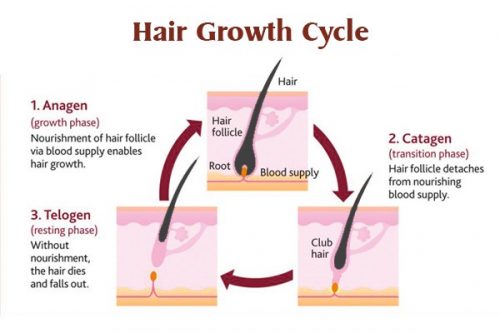Hair goes through three main stages of growth:
- Anagen stage, the growth stage, can last 2 -7 years.
- Catagen stage, the transitional stage, lasts about 3 weeks.
- Telogen stage, the resting and shedding stage, lasts a little over 3 months.
These cycles are repeated continuously throughout your life. The length of each stage depends on many factors, some are: heredity, health, diet, stress, medications and/or poor scalp maintenance.
ANAGEN STAGE
The anagen phase is the active growth stage of hair follicles, a time when the cells of the hair follicle are dividing rapidly, adding to the hair shaft.
During this phase the hair grows about 1 cm (1/3”) every 28 days. Scalp hair stays in this active phase of growth for 2-7 years. This phase is mostly genetically determined and varies person to person.
Some people naturally have longer anagen phases and can grow their hair very long, while others will never see their hair get very long.
At any time, about 80% – 90% of the hairs on your head are in the anagen growth stage..
CATAGEN STAGE
The catagen phase is a short transitional stage, it signals the end of the growth cycle.
The hair detaches from the blood supply but remains in place until it is shed, it is referred to as a club hair.
The catagen phase last around 2-3 weeks, with about 10% of the hair on your head.
TELOGEN
During the telogen phase the hair sheds and the follicle gets to rest before producing a new hair and starting the growth cycle again.
Accordingly, it is normal to lose about 100 -150 hairs each day.
When trouble arises within the cycle…
Telogen Effluvium
If affected by telogen effluvium, more hairs than normal enter the resting phase (telogen) and are shed.
Effluvium means “flowing out” in Latin, and this loss is often distressing to those experiencing it. Many different factors may cause more hairs than normal to enter telogen effluvium state.
Common causes include but are not limited to:
- Childbirth when hormones are changing.
- Illnesses especially those causing high fever.
- Autoimmune diseases that affect the blood.
- Surgery anesthesia and medications required
- Emotional stress such as death and divorce.
- Significant weight loss
- Unbalanced diet
- Medications including beta blockers, anticoagulants and antidepressants.
- Stopping birth control pills.
The trigger for hair loss commonly occurs 3 months before hair loss is noticed because it usually takes that long for hair to go from anagen to telogen. In many cases, no trigger is identified.
No treatment is needed for telogen effluvium since it is a condition that gets better on its own. There is no permanent damage to the hair follicles, and new hairs grow in the place of those lost.
In cases where telogen effluvium is caused by ongoing stress to the body such as an overly restrictive diet or chronic emotional stress, hair loss will not stop until the underlying cause is resolved.

One thought on “Hair Growth Cycle”
Hello Margert! I really like you website! The layout is very nice, makes me want to change my theme. I am working on building my site, it has been a challenge! I would be honored to share my information with you and your visitors!
Thank you